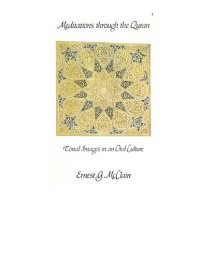
Ebook: Meditations through the Quran: Tonal images in an oral culture
Author: Ernest G. McClain
- Genre: Other Social Sciences // Cultural
- Tags: divine proportion, sacred geometry, number symbolism
- Year: 1981
- Publisher: Nicolas Hays
- City: York Beach
- Language: English
- pdf
Meditations through the Quran is an important work for all students of number, music and religion. Ernest G. McClain studies an ancient tonal influence on the images and metaphors in the Quran while giving the Westerner a glimpse of the philosophical implications of its beauty and poetry. A possible musical symbolism in the Ka'ba and its relation to arithmetical elements in Hindu, Buddhist and Judaeo-Christian texts is explored. His appendix on the Holy Mountain explicates a harmonical matrix which has been fundamental to all the world religions. About the author: https://en.wikipedia.org/wiki/Ernest_G._McClain
»Applying his vast knowledge of harmonics to the study of the Ka'ba, Ernest McClain reveals how this central symbol of Islam is related to the harmonic proportions of the Sumerian ark, the Prajapati cycle, the Platonic m yth of A tlantis, and in fact, to the interior dimension of all known traditions of antiquity—in accordance with the nature of Islam—and as a final revelation and synthesis of all his previous harmonic revelations.
Before being the source of Islamic ethics, jurisprudence, cosmology and sacred history, the Quran is a world of sacred sound, the Word of God, whose chanting fills space and transforms the matrix of ordinary life into vibrations of the Divine Presence. It is this immediate and primordial experience of the Quran—as aural revelation—as a message from Heaven, to be heard before being read or analyzed, that is dealt with in this work of exceptional value. The fact that a scholar who is not a philologist of Arabic (or other Semitic languages) but a musician and expert on Pythagorean harmony should be able to write this book—which reveals a great deal more of the meaning and inner reality of the Quran than most Western "scholarly" analyses of its language and content—is itself proof of the primacy of the aural experience related to this final revelation of the present human cycle.
Altogether, Meditations through the Quran is one of the most surprisingly valuable and worthwhile works in Islamic studies to appear in recent years. It is certainly one of the most significant works on the Quran in English, and it addresses itself not only to scholars of Islam, but to all human beings attracted to matters of the spirit. The last section of the book is devoted to the "Holy Mountain" and summarizes Biblical number symbolism and harmonics, and is a tour de force worthy of long periods of meditation and study.
I recommend this book to all those interested in Islam, as well as to those interested in traditional harmonics. This is one of the few works in a European language that can provide a bridge for an understanding of the significance of the Quran as the central theophany of Islam as well as being a Sacred Book which speaks to contemporary men and women everywhere.« (From a review by Seyyed Hossein Nasr)
»Applying his vast knowledge of harmonics to the study of the Ka'ba, Ernest McClain reveals how this central symbol of Islam is related to the harmonic proportions of the Sumerian ark, the Prajapati cycle, the Platonic m yth of A tlantis, and in fact, to the interior dimension of all known traditions of antiquity—in accordance with the nature of Islam—and as a final revelation and synthesis of all his previous harmonic revelations.
Before being the source of Islamic ethics, jurisprudence, cosmology and sacred history, the Quran is a world of sacred sound, the Word of God, whose chanting fills space and transforms the matrix of ordinary life into vibrations of the Divine Presence. It is this immediate and primordial experience of the Quran—as aural revelation—as a message from Heaven, to be heard before being read or analyzed, that is dealt with in this work of exceptional value. The fact that a scholar who is not a philologist of Arabic (or other Semitic languages) but a musician and expert on Pythagorean harmony should be able to write this book—which reveals a great deal more of the meaning and inner reality of the Quran than most Western "scholarly" analyses of its language and content—is itself proof of the primacy of the aural experience related to this final revelation of the present human cycle.
Altogether, Meditations through the Quran is one of the most surprisingly valuable and worthwhile works in Islamic studies to appear in recent years. It is certainly one of the most significant works on the Quran in English, and it addresses itself not only to scholars of Islam, but to all human beings attracted to matters of the spirit. The last section of the book is devoted to the "Holy Mountain" and summarizes Biblical number symbolism and harmonics, and is a tour de force worthy of long periods of meditation and study.
I recommend this book to all those interested in Islam, as well as to those interested in traditional harmonics. This is one of the few works in a European language that can provide a bridge for an understanding of the significance of the Quran as the central theophany of Islam as well as being a Sacred Book which speaks to contemporary men and women everywhere.« (From a review by Seyyed Hossein Nasr)
Download the book Meditations through the Quran: Tonal images in an oral culture for free or read online
Continue reading on any device:

Last viewed books
Related books
{related-news}
Comments (0)